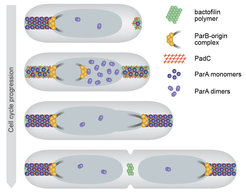New insights into the bacterial cytoskeleton: bactofilin polymers organize the chromosome segregation machinery in Myxococcus xanthus
Bacteria contain various polymer-forming proteins that mediate fundamental cellular processes such as cell growth, DNA segregation, and cell division. These do not only include homologs of actin, tubulin and intermediate filament proteins, which typically constitute the cytoskeleton of eukaryotic cells, but also proteins that are exclusively found in the bacterial world. Among the bacteria-specific factors are the bactofilins, a family of small proteins that were identified in the research group of Martin Thanbichler at Philipps University Marburg and are characterized by a prion-like, β-helical fold. Bactofilins are widespread among bacteria, with many species containing more than one of bactofilin homolog.
Work by the Thanbichler and Søgaard-Andersen labs has now shown that, in M. xanthus, three different bactofilins interact to form polymeric structures that extend from the two cell poles toward the cell center. The pole-distal ends of these structures bind to a protein complex located at the chromosomal replication origins, thereby ensuring the proper arrangement of chromosomal DNA within the cell. At the same time, the bactofilin structures interact with a protein that drives the segregation of replicated DNA into the daughter cell compartments. This interaction is mediated by a newly identified adapter protein, which covers the polymers along their entire length and likely contributes to controlling the dynamics of the chromosome segregation process. The results of this study reveal a novel role for bactofilins in chromosome organization. Moreover, they for the first time provide detailed insight into the mechanisms that enable these cytoskeletal elements to control the positioning of other macromolecules within the cell.

Organization of the M. xanthus chromosome segregation machinery by bipolar bactofilin structures. Bactofilins assemble in a cell cycle-dependent manner. They interact with the adapter protein PadC, which in turn captures ParA monomers and thus mediates their retention in the subpolar regions of the cell. The tips of the bactofilin structures bind to origin-associated ParB·parS complexes, thereby ensuring the proper arrangement of the two sister chromosomes after their segregation by nucleoid-associated ParA dimers.
Intriguingly, one of the bactofilins investigated in this study has previously also been implicated in the positioning of a protein involved in the regulation of M. xanthus motility. The bactofilin cytoskeleton thus appears to serve as a multi-purpose scaffold that helps to organize multiple, seemingly independent cellular pathways. Given the almost universal distribution of bactofilins among bacteria, it will be exciting to investigate the roles of these proteins in other bacterial species and, thus, determine the full range of functions they can perform.
Reference:
Lin, L., Osorio Valeriano, M., Harms, A., Søgaard-Andersen, L., Thanbichler, M. (2017) Bactofilin-mediated organziation of the ParABS chromosome segregation system in Myxococcus xanthus. Nature Communications 8, 1817.












